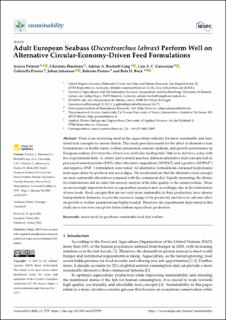| dc.contributor.author | Petereit, Jessica | |
| dc.contributor.author | Hoerterer, Christina | |
| dc.contributor.author | Bischoff-Lang, Adrian A. | |
| dc.contributor.author | Conceição, Luís E. C. | |
| dc.contributor.author | Pereira, Gabriella | |
| dc.contributor.author | Johansen, Johan | |
| dc.contributor.author | Pastres, Roberto | |
| dc.contributor.author | Buck, Bela H. | |
| dc.date.accessioned | 2023-03-20T14:12:09Z | |
| dc.date.available | 2023-03-20T14:12:09Z | |
| dc.date.created | 2022-09-21T08:50:59Z | |
| dc.date.issued | 2022-06-14 | |
| dc.identifier.citation | Sustainability. 2022, 14 (12), 1-18. | en_US |
| dc.identifier.issn | 2071-1050 | |
| dc.identifier.uri | https://hdl.handle.net/11250/3059338 | |
| dc.description.abstract | There is an increasing need in the aquaculture industry for more sustainable and functional feed concepts for marine finfish. This study provides results for the effect of alternative feed formulations on health status, welfare parameters, sensory analysis, and growth performance in European seabass (Dicentrarchus labrax) over an 83-day feeding trial. Fish were fed twice a day with five experimental diets. A control diet (control) and four different alternative feed concepts rich in processed animal proteins (PAP), other alternative ingredients (NOPAP), and a positive (NOPAP+) and negative (PAP−) formulation were tested. All alternative formulations contained hydrolysates from aquaculture by-products and macroalgae. The results indicate that the alternative feed concepts are more sustainable alternatives compared with the commercial diet. Equally interesting, the alternative formulations did not affect the sensory analysis of the fillet quality or the animal welfare. These are increasingly important factors in aquaculture products and, accordingly, also in the formulation of new feeds. Feed concepts that are not only more sustainable in their production, have shorter transportation distances, recycle the resources (usage of by-products), and have no adverse effect on growth or welfare parameters are highly needed. Therefore, the experimental diets tested in this study are a win-win concept for future seabass aquaculture production. | en_US |
| dc.language.iso | eng | en_US |
| dc.publisher | MDPI | en_US |
| dc.rights | Navngivelse 4.0 Internasjonal | * |
| dc.rights.uri | http://creativecommons.org/licenses/by/4.0/deed.no | * |
| dc.title | Adult European Seabass (Dicentrarchus labrax) Perform Well on Alternative Circular-Economy-Driven Feed Formulations | en_US |
| dc.title.alternative | Adult European Seabass (Dicentrarchus labrax) Perform Well on Alternative Circular-Economy-Driven Feed Formulations | en_US |
| dc.type | Peer reviewed | en_US |
| dc.type | Journal article | en_US |
| dc.description.version | publishedVersion | en_US |
| dc.rights.holder | © 2022 by the authors | en_US |
| dc.source.pagenumber | 1-18 | en_US |
| dc.source.volume | 14 | en_US |
| dc.source.journal | Sustainability | en_US |
| dc.source.issue | 12 | en_US |
| dc.identifier.doi | 10.3390/su14127279 | |
| dc.identifier.cristin | 2053736 | |
| dc.relation.project | EC/H2020/773330 | en_US |
| dc.source.articlenumber | 7279 | en_US |
| cristin.ispublished | true | |
| cristin.fulltext | original | |
| cristin.qualitycode | 1 | |

